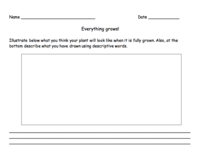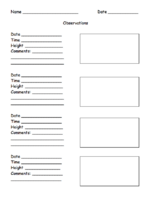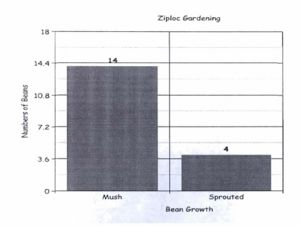Ziploc Gardening
| Instant wiki maker | Making handouts | Editing tips |
Contents
- 1 Ziploc (c) Gardening
- 1.1 Student worthiness
- 1.2 Primary biological content area covered
- 1.3 Materials
- 1.4 Handouts
- 1.5 Description of activity
- 1.6 Lesson plan
- 1.7 Potential pitfalls
- 1.8 Science Connections
- 1.9 Math connections
- 1.10 Literature connections
- 1.11 Connections to educational standards
- 1.12 Next steps
- 1.13 When disaster strikes
- 1.14 Citations and links
Biology In Elementary Schools is a Saint Michael's College student project from a course that ran between 2007 and 2010 and fully described in this book chapter. The student-created resources have been preserved here for posterity. Link under 'toolbox' for printer-friendly versions of the exercises. Click on handouts to print full resolution versions. Please see Wikieducator's disclaimer, our safety statement, and the Creative Commons licensing in English and in legalese.
Ziploc (c) Gardening
Student worthiness
This activity was tried at least once by multiple students and was successful.
Primary biological content area covered
Plant life acycles; Observing and recording; Reflecting; Investigating; Hands-on learning.
Materials
- 1 Quart size clear plastic Ziploc(c) bag for each student
- Paper towels
- Water
- A variety of dried beans (i.e. lima, kidney, baby bop)
- Permanent marker
- Copies of observation handouts
- Hand lenses
- Ruler
- Clear box or basket to prop the bags up (we found that bags left flat tended to have books and other objects placed on top resulting in pulverized beans)
Handouts
Students should use the worksheet entitled "Everything grows!" to illustrate and describe their predictions about what they think the plants will look like when they are finished growing. Students should also have the worksheets entitled "Observations" so they can illustrate and record their observations during plant growth in order to then go back and compare their predictions to the final plant.
Description of activity
This activity is fairly straightforward and simple. Each student will grow one to three plants from various beans that are placed in a bag. As the plants grow, students will observe how the appearances change daily, and then again over a longer period of time, such as two weeks.
Lesson plan
- Soak the beans in water for at least 24 hours prior to doing this activity with students.
- Once soaked, each student should receive a plastic bag, a paper towel and three different types of beans.
- The students will first identify (with help from a guide or the teacher) what type of beans they have, and then label the bag accordingly.
- They will then fold the paper towel into quarters and dampen it.
- Next, students will place the moist paper towel into the bag with the beans.
- Make sure the student can identify which bean is which, so they can have a better record of growth for each bean. This is why labeling where each type of bean is located is important.
- Walk around the room, observing the students. Consider quizzing them on which bean is which, asking them critical questions, such as "What is different about the lima bean compared to the kidney bean?"
- The students should then blow some air into the bags and seal the bags. Assistance may be needed during this part.
- The bags should be placed in an open box or basket somewhere in the classroom where they will get plenty of sunlight. An interesting experiment would be to place some in the dark where the beans will tend to bolt for light.
- Using their "Observations" worksheet, students should observe and record their plants everyday for about two weeks, watching for signs of growth. Measurements of growth (in mm) should be included on this worksheet so that students can use specific data later in graphing.
Potential pitfalls
The most obvious pitfall of this activity is that one or more of the students' plants may not grow. Make sure all the plastic bags are sealed completely so the moisture does not escape. If the moisture escapes, the plants may not grow. However, if the paper towel inside the bag does dry out, it can be moistened by adding some more water without removing anything from the bag, just make sure the bag has some air inside and the zipper is sealed tight in order to prevent the water from evaporating again. Mold growth is a potential problem that can lead to allergic reactions. If mold grows and you decide not to dispose of the bag, it would be important to take it outside before opening to add water.
Science Connections
Besides looking at plant growth, this activity can also be linked to the water cycle. You can explain how the beans and wet paper towel create their own ecosystem in the Ziploc bag through evaporation and transpiration. The anatomy of beans and seeds can also be explored by dissecting samples of each bean used.
Math connections
Students will be able to measure the size of their bean sprout growth using a ruler. This can lead them to fractions and decimals as the bean will grow slowly. They can make comparisons throughout their records during the different stages.
Students can also make graphs of their findings to supply them with a clearer picture of the actual growth taking place in each step of the plant's development. Put time (in days) on the x-axis and length (in millimeters (mm)) on the y-axis. Plot the points over time and then students can connect the data points to form a line graph. Students can also compare graphs with one another identifying potential reasons why some beans did not grow as well as others.
Literature connections
|
|
One could read the book The Gardener, a picture book about gardening, by Sarah Stewart. Another book that would pair well with this lesson is The Giving Tree, written by Shel Silverstein. Tell Me, Tree, by Gail Gibbons is also a good picture book that talks about photosynthesis and how to identify different types of plants and trees. Kate and the Beanstalk by Mary Pope Osborne (Author), Giselle Potter (Illustrator); Anne Schwartz Books.
A seed is sleepy by Dianna Hutts Aston and illustrated by Sylvia Long is both beautiful and informative. It is a rare combination of well-written and accurate scientific content and great art; Chronicle Books, San Francisco, CA, 2007.
Connections to educational standards
Vermont Grade Expectations:
S3-4:2 Students demonstrate their understanding of predicting and hypothesizing by... Identifying simple patterns of evidence used to develop a prediction and propose an explanation.
S3-4:4 Students demonstrate their ability to conduct experiments by... Recording data at various points during an investigation by reporting what actually happens, even when data conflicts with expectations AND Recording the sequence in which events take place.
M3: 23 Interprets a given representation (line plots, tally charts, tables, or bar graphs) to answer questions related to the data, to analyze the data to formulate conclusions, or to make predictions.
Next steps
This activity is an introduction to a lesson or unit about plant life cycles. The plants that the students have grown can be used to identify parts of a plant in a later activity for the unit (ex. seed, roots). This lesson could also be compared to humans looking at how and what we need for our bodies to grow.
When disaster strikes
So what can you do when a pile of books crushes your experiment and the plants are reduced to mush? A third-grade teacher at out partner school provided the answer: you graph the result and turn it into a positive learning experience.
Citations and links
This lesson was adapted from kidzone.
Vermont State Grade Expectations can be found at the State of Vermont Department of Education website. [1]




